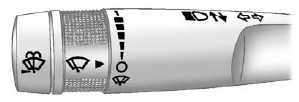Turn and Lane-Change Signals

An arrow on the instrument panel cluster flashes in the direction of the turn or lane change.
Move the lever all the way up or down to signal a turn.
Raise or lower the lever until the arrow starts to flash to signal a lane change. Hold it there until the lane change is completed. If the lever is briefly pressed and released, the turn signal flashes three times.
The lever returns to its starting position whenever it is released.
If after signaling a turn or lane change the arrow flashes rapidly or does not come on, a signal bulb might be burned out.
Have the bulbs replaced. If the bulb is not burned out, check the fuse.
See Fuses and Circuit Breakers on page 10‑31.
Turn Signal On Chime
If either one of the turn signals is left on and the vehicle has been driven more than 1.2 km (0.75 mi), a chime will sound.
See also:
Express-down Windows
Vehicles with the express-down feature allow the driver and front passenger windows to be lowered without holding the switch. Push the switch down to the second detent, then release, to activate the e ...
Compass Messages
CAL
This message is displayed when the compass needs to be calibrated. See Compass
on page 5‑5.
– – –
Three dashes will be displayed if the compass needs service. See your dealer
fo ...
Engine Oil Pressure Light
WARNING
Do not keep driving if the oil pressure is low. The engine can become so hot that it catches fire.
Someone could be burned. Check the oil as soon as possible and have the vehicle serviced. ...





